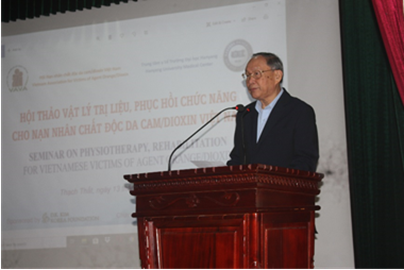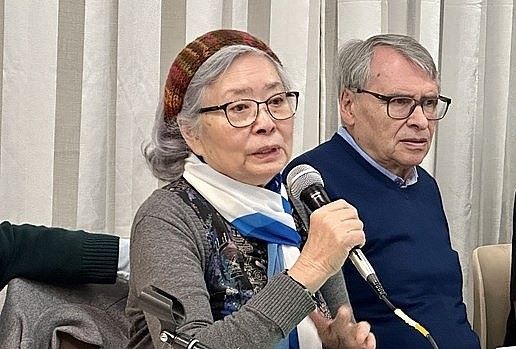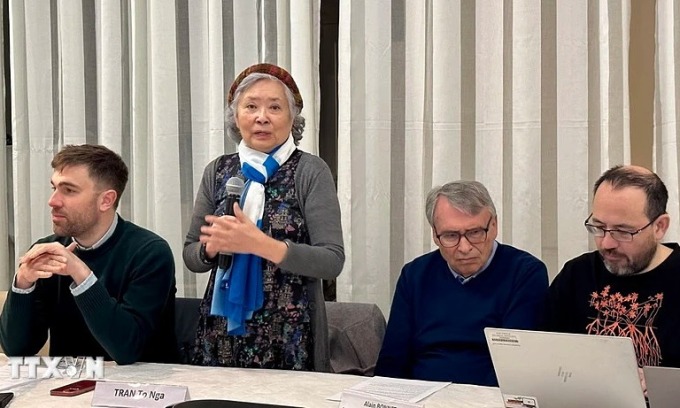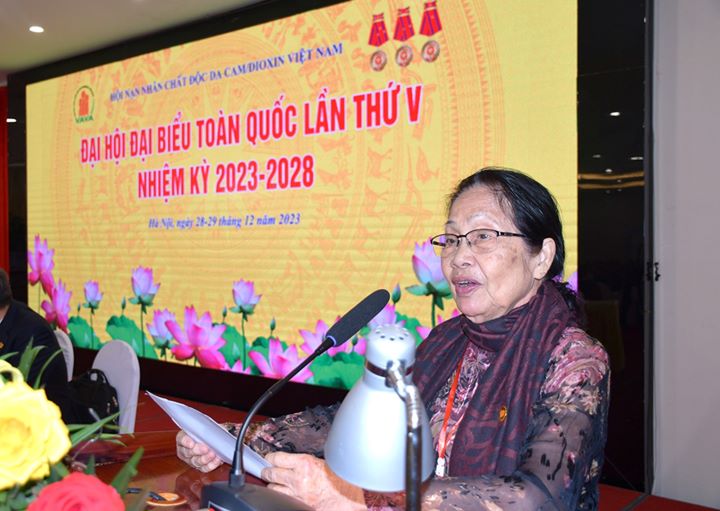Post I. Unrelenting pain
One afternoon in August, Senior Lieutenant General Nguyen Van Rinh welcomed us in a simple small room located on the 2nd floor of VAVA’s head office. His desk is full of documents and pictures about dioxin sequelae that are still present in Vietnam decades after the war.
61 years ago, the US military began spraying Agent Orange/dioxin - one of the most toxic chemicals to humans - on the forests of Vietnam. According to statistics of the Chemical Corps, under the Ministry of National Defense, in just 10 years from 1961-1971, as much as 80 million liters of herbicides were used in southern Vietnam in Operation Ranch Hand to defoliate the forests and destroy crops. Of these, more than 71.8 million liters consist of agent orange matter, white matter, blue matter, purple matter and pink matter mixed with dioxin.

Directly witnessing the "rain of Agent Orange" on the southern forests, General Rinh recalled: In 1967, he entered Battlefield B. At that time, the soldiers saw the American Military spray chemicals. They even got wet from these chemicals. Only a few days later, the forest trees died, losing all their leaves. But, at that time, they never knew the long-lasting and painful consequences that the chemicals would bring to them.
Toxic chemicals were sprayed over a quarter of southern Vietnam’s area with over 3 million hectares of forests destroyed, causing the loss of about 112 million m3 of timber. There are nearly 26,000 villages being affected. In which, 86% of the area was sprayed with poison twice and 11% was sprayed 10 times. A total of 366 kg of dioxin was sprayed over a quarter of the total area of South Vietnam which was 17 times higher than the allowed limit in US agriculture.
More painfully, in this "biggest chemical war in human history", as many as 4.8 million Vietnamese people were exposed, in which about 3 million became AO victims.
Scientific studies and reality both show that Agent Orange used in the Vietnam War relates to cancer, diabetes and fetal malformations, leaving sequelae for the next generations. In addition to hundreds of thousands of people who have died of exposure to this terrible poison, their descendants are also struggling with sequelae and serious diseases such as total or partial paralysis, blindness, deaf-mute, intellectual disability, mental illness, cancer, deformities, birth defects...
General Rinh gave us a nearly 500-page yearbook containing studies on the terrible effects of dioxins on the human body. According to the results of basic surveys on the health status of Agent Orange victims in some southern provinces of Vietnam, up to 23.7% of the surveyed people have 1-3 children with disabilities; 5.7% of them have grandchildren with disabilities. The rate of cancer is 14.9%, mostly the victims of over 50 years old. Through the basic survey, it can be seen that most of the victims have poorer health than the normal people in Vietnam.
According to incomplete statistics, currently in Vietnam there are more than 15,000 second-generation victims, 35,000 third-generation victims and 2,000 fourth-generation victims.
In addition to serious effects on human health, toxic chemicals sprayed by the US in Vietnam also inflict serious consequences on the ecological environment. To date, as many as 28 locations are still likely to be contaminated with dioxins, endangering Vietnam's food supply and affecting human health. The airports of Bien Hoa (Dong Nai), Da Nang, Phu Cat (Binh Dinh) and A So (Thua Thien Hue) were identified as the most heavily affected areas when dioxin contamination concentrations are much higher than the limit. These airports alone have an area of more than 735,000m2.
Most typically, Bien Hoa airport, the largest base of Operation Rich Hand. This was also where 170,000 containers of herbicides were stored and used, each containing 208 liters, including 98,000 barrels of Agent Orange, 45,000 barrels of white matter and 16,000 barrels of green matter.
“Victims are not only soldiers who directly participated in the resistance war or people living in the contaminated areas but their descendants, second, third, and even fourth generations as well. Many of them are many comrades. Up to now, 350,000 victims have been entitled to favorable policies, but the actual number of victims is much higher,” said General Rinh.
Post II. The journey for justice is orange
Although many years have passed, Senior Lieutenant General Nguyen Van Rinh - former Deputy Minister of Defense, President of the Vietnam Association for Victims of Agent Orange/Dioxin (VAVA) still cannot forget his 5 year journey in pursuit of justice for the victims of this evil chemical.
Not only in Vietnam, even American veterans who fought in the war had to face the persistent "Agent Orange Syndrome". In the late 1970s, American veterans in the Vietnam War officially sued. In 1984, a settlement was made when American chemical companies, including Dow Chemical, Monsanto and several others, accepted a compensation of $180 million for US veterans affected by this toxic chemical.
However, with more than 4.8 million Vietnamese victims, the journey for justice is much more arduous and difficult.
"Our legal basis is to condemn American chemical companies for violating international law, first of all, the 1925 Geneva Protocol for the Prohibition of the Use in War of Asphyxiating, Poisonous or Other Gases, and of Bacteriological Methods of Warfare, and other bills and case laws in the United States".
Pausing for a while, General Rinh said: In early 2004, VAVA was officially established. Less than a month later, the Association decided to sign a lawsuit against American chemical companies to seek justice for the victims of Agent Orange with the help of progressive lawyers as well as the International Democratic Lawyers Association and Vietnam Lawyers Association.
Specifically, on January 31, 2004, VAVA sued 37 American companies to ask for their liability and compensation for producing this chemical. Dow Chemical and Monsanto, the two largest Agent Orange producers for the US military, among others, were named in the lawsuit.
“We filed the lawsuit in Brooklyn Magistrates Court, New York. Our legal basis is to condemn US chemical companies for violating international law, first of all, the 1925 Geneva Protocol for the Prohibition of the Use in War of Asphyxiating, Poisonous or Other Gases, and of Bacteriological Methods of Warfare and other bills and case laws in the US”, said General Rinh.
Initially, plaintiffs consisted of only 3 people, but later grew to more than 30 people, representing 3 million victims. In particular, among these are some children of the victims.
Simultaneously, a campaign of propaganda and mobilization to support the victims physically and mentally was also launched by VAVA. 1.5 million people have agreed to sign in to support the fight for justice.
On March 10, 2005, Judge Jack Weinstein of the Federal Court in Brooklyn dismissed the lawsuit, holding that the claims had no legal basis. The judge argued that Agent Orange was not considered a prohibited poison under international law at the time of its use by the United States; and that the United States is not prohibited from using it to kill weeds, and that the companies that manufactured the substance are not responsible for the use of the US government.
Not accepting this argument, on April 7, 2005, the Layers Association representing Vietnamese victims filed a petition asking the Federal Court of Appeals in New York to re-trial and veto the previous ruling of Judge Jack Weinstein. However, on February 22, 2008, the US Federal Court of Appeal in New York continued to reject the lawsuit filed by Vietnamese Agent Orange/dioxin victims against US chemical companies on the use of Agent Orange/dioxin in the Vietnam War and kept the first-instance judgment.
International public opinion had many criticisms of this decision of the US Federal Court of Appeal. On March 18, 2008, the American Layers Association and the International Association of Democratic Lawyers including 10 members came to Vietnam to provide legal assistance to the victims in the upcoming lawsuit to the US Supreme Court.
On October 6, 2008, the plaintiff continued to file a petition with the US Supreme Court but was rejected on March 2, 2009.
In his memoirs, the late Assoc. Prof. Dr. Tran Xuan Thu (former Vice President - General Secretary of VAVA) wrote: "The case has gone through 3 levels of first instance, appellate and supreme. We have not succeeded legally, but the case has won a significant social and human victory as awakening human conscience”.
On April 18, 2017, the International Court of Monsanto in La Hague, Netherlands announced the conclusion that the Monsanto company had destroyed the environment, causing damage to the people of Vietnam. Because this is a citizen trial, the conclusion is only a consultation recommendation, not legally binding.
In addition, the 3 trials lasting for 5 years also made the US authorities show their responsibility to overcome the consequences of the chemical war they had caused in Vietnam.
In May 2007, the US Congress allocated a budget of 3 million USD to overcome the consequences of Agent Orange on the environment in some of the hottest spots and in 2009 this amount increased to 6 million USD. As of January 1, 2016, the US Government has spent 173 million USD for remedial work in Vietnam.
General Rinh said that currently, the US has been implementing detoxification projects at military airports affected by dioxin, and committed to helping disabled victims in the 8 most affected provinces such as Quang Tri, Tay Ninh, Dong Nai…
The journey does not stop
Continuing the journey to seek justice for the victims of Agent Orange, in May 2014, Ms. Tran To Nga - a Vietnamese citizen of France filed a lawsuit against US chemical companies to the French court.
Nga is the only plaintiff who is a French citizen and has enough medical evidence to be a victim of dioxin, so that she and her friends at home and abroad prepared for the lawsuit for the past 10 years.
Although she was rejected by the court, Nga is still very persistent. The journey to demand for justice for AO victims will not stop.



_thumb_720.jpg)


_thumb_720.jpg)
_thumb_720.png)


_thumb_720.jpg)




















Comment